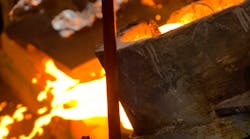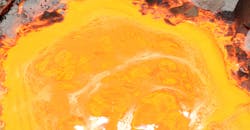The oxygen atom’s presence in molten iron produces many harmful effects, nearly all unknown to iron foundries. Few, if any, countermeasures are taken to address oxidation during melting. The industry simply accepts free oxygen as a normal part of molten iron.
A basic fact is that molten iron is oxidized by atmospheric contact. The steel industry goes to great lengths attempting to stop oxidation via tightly shrouding molten steel, but this action fails in the end. Steelmakers treat the critical steel grades with aluminum, which ties up the free-oxygen atoms chemically in inert oxide molecules, thereby controlling the oxygen atoms’ harmful effects.
This simple solution is effective in steel casting too, but it cannot be used in iron casting: Elevated aluminum levels (0.03-0.04% Al) are associated with pinhole defects in iron casting.
Free oxygen atoms do not enter the molten iron bath directly. The first step is that iron oxide is formed on the iron bath surface, where contact with the atmosphere happens. Then, iron oxide instantly establishes the chemical equilibrium equation, FeO = Fe + O. The “O” is the free-oxygen atom and it quickly enters the iron bath.
When free-oxygen atoms are released into molten iron baths, the Laws of Thermodynamics determine which element in the bath they react with: At temperatures above 2,600°F, carbon is oxidized; below 2,600°F, silicon is oxidized.
But, the oxidation of carbon and silicon is only the tip of the iceberg. Iron, manganese, and other elements are continuously oxidized too. Iron oxide is reformed and distributed throughout the bath.
One of the consequences of free-oxygen atoms entering the molten bath is nanosized oxides precipitating throughout the bath. These oxides trigger further chemical reactions and formations and create physical impairments within the liquid and solidified iron.
Multi-point analysis — Several quick points illustrating the adverse effects of oxide precipitation are:
1) Oxidation of carbon and silicon causes the loss of these elements to metal chemistry – and significant financial loss.
2) Precipitated nanosized oxides act as thickeners to metal flow, decreasing fluidity.
3) Precipitated nanosized oxides provide crack initiation sites in the metal matrix, reducing strength and ductility.
4) Iron oxide distributed throughout the bath causes spinel formations, directly responsible for inductor loop plugging, furnace spout, inlet plugging, and sidewall furnace buildup.
5) Continual precipitation of nanosized oxides during casting produces casting defects that account for 30-70% of a foundry’s current scrap rate.
6) Precipitation of oxides in the matrix significantly decreases the casting machinability index.
7) Free oxygen atoms cause magnesium fade in ductile iron.
8) The free-oxygen atom level in the base iron directly affects the volume of magnesium necessary to make ductile iron.
There are many more adverse effects, too, and these will be addressed in further detail in subsequent reports.
There also is much to be said about the improved quality of molten metal created with “oxygen-free" iron. And, much can be said concerning iron oxide in cover slag:
1) Iron oxide instantly forms on molten iron surfaces in contact with the atmosphere.
2) Iron oxide in slag causes the crustiness some slags exhibit.
3) Iron oxide-free slag is manageable, non-sticky to refractory, does not form blockages, and should not be removed
4) Full slag cover should be used to create a barrier to atmospheric contact once iron oxide is removed.
4) Iron oxide in slag overwhelms refractory, causing refractory to be chemically eroded regardless of refractory quality.
5) Iron oxide-free slag allows refractory quality to be the main controller of refractory performance and service life
6) Iron oxide-free slag eliminates slag line erosion in furnaces.
7) Iron oxide-free slag stops sulfur reversion in ductile iron.
8) Iron oxide present in slag must be chemically reduced by special materials added to the slag mass. It cannot be physically removed.
9) Removing cover slag, exposing clean molten metal to the atmosphere, causes higher levels of iron oxide in the newly formed slag.
Molten metal deoxidation — Once oxygen atoms have been released into the iron bath, nothing can be done to keep them from “oxidizing” some element. The Laws of Thermodynamics prevail, always.
Because oxygen atoms cannot be removed, Mastermelt engineers determined to reduce iron oxide chemically, using silicon carbide. However, silicon carbide’s reactivity with iron oxide is dependent on certain properties developed during its manufacture. Not all silicon carbide is the same and not all silicon carbide reacts with iron oxide.
Their goal was to develop a de-oxidizing material that would reduce iron oxide by converting its harmful nature into inert by-products. After a long process of testing and research, Mastermelt identified certain grades of silicon carbide that are highly reactive with iron oxide and incorporated these into the DeOX de-oxidation product for electric furnace or cupola melting.
In electric furnaces, DeOX is added with the furnace charge, or with the initial charge if multiple charges are made. Normal melting practice is maintained thereafter. DeOX simply reduces all iron oxide inside the furnace. All carbon and silicon loss is stopped.
Only one melt practice change is required. Slagging at the end of melt cycle should be prolonged to occur just prior to transport, which is designed to reduce the cleaned bath’s contact time with the atmosphere.
In cupola melting, DeOX is injected through one or two tuyeres, and reduces all iron oxide produced in the tuyere raceways. Because iron-oxide formation begins when melting commences, DeOX injection should begin at or before tap-out. Tap-out chemistry, which represents the true cupola charge chemistry before iron oxide formation in the raceway causes its decline, will be maintained throughout the melt campaign. All carbon and silicon oxidation losses are stopped.
The carbon losses stopped are those that occur in the tuyere raceway area. Most of these carbon losses went unnoticed in the past, so DeOX provides an instant jump in carbon level — from 0.35% C to 0.90% C depending on the loss that had been occurring. This increase in carbon recovery produces significant coke rate reductions. Each cupola operation can determine the carbon pickup that DeOX will provide simply by checking the tap-out chemistry as compared to that after several hours melting.
During iron melting, in both cupolas and electric furnaces, free-oxygen atoms enter the molten iron mass. Unrestrained, they accrue to the level of 4 to 9 parts per million. These extremely low levels of contamination show the tenacity of the oxygen atom (5 PPM = 0.0005 %.) The inert level of oxygen, the level where oxygen no longer causes harm, nears 1-2 PPM, and is dependent on metal temperature. Higher metal temperatures correspond to higher oxygen inert levels. Metal chemistry also influences the inert level.
Typical cupola melting foundries test at 5-9 PPM oxygen. In cupola melting, the free-oxygen level is directly related to the coke rate, but seldom lower than 5 PPM.
In EF melting, the free-oxygen level is more dependent on metallic scrap selection and iron oxide contamination present within the furnace charge. In cupola melting, iron oxide is produced within the cupola with metallic-charge contamination seemingly unimportant.
Two methods are available to determine free oxygen’s influence on a foundry’s casting products. One calls for measuring the actual free-oxygen content in the molten iron. This requires the oxygen meter commonly used in steelmaking but never found in the iron-making industry. (One of these meters has been made available by Reno Refractories and its use can be scheduled for analyzing a specific foundry’s iron quality.)
The second method is to determine the iron-oxide level in the cover slag or melting/holding/pouring furnace slag, which can be correlated to a free-oxygen level based on the extensive testing we have performed over years of testing.
Cost savings — Removing free oxygen from molten metal produces significant savings. At one large cupola operation, oxidation losses exceeded $50,000/day, which is easily saved. Oxidation losses make up a significant and important portion of an iron foundry's operating costs. These oxidation losses can be stopped using DeOX product.
Melting personnel need to be relieved of the burden produced by the free-oxygen atoms in molten iron. Iron melting is much simpler, less frustrating, and less strenuous when the free-oxygen atom, is under control. DeOX makes free oxygen control a very easily attained goal.
This is the first in a series of reports addressing the effects of oxygen in iron melting.
Ron Beyerstedt is the president of Mastermelt LLC. Contact him at [email protected]










